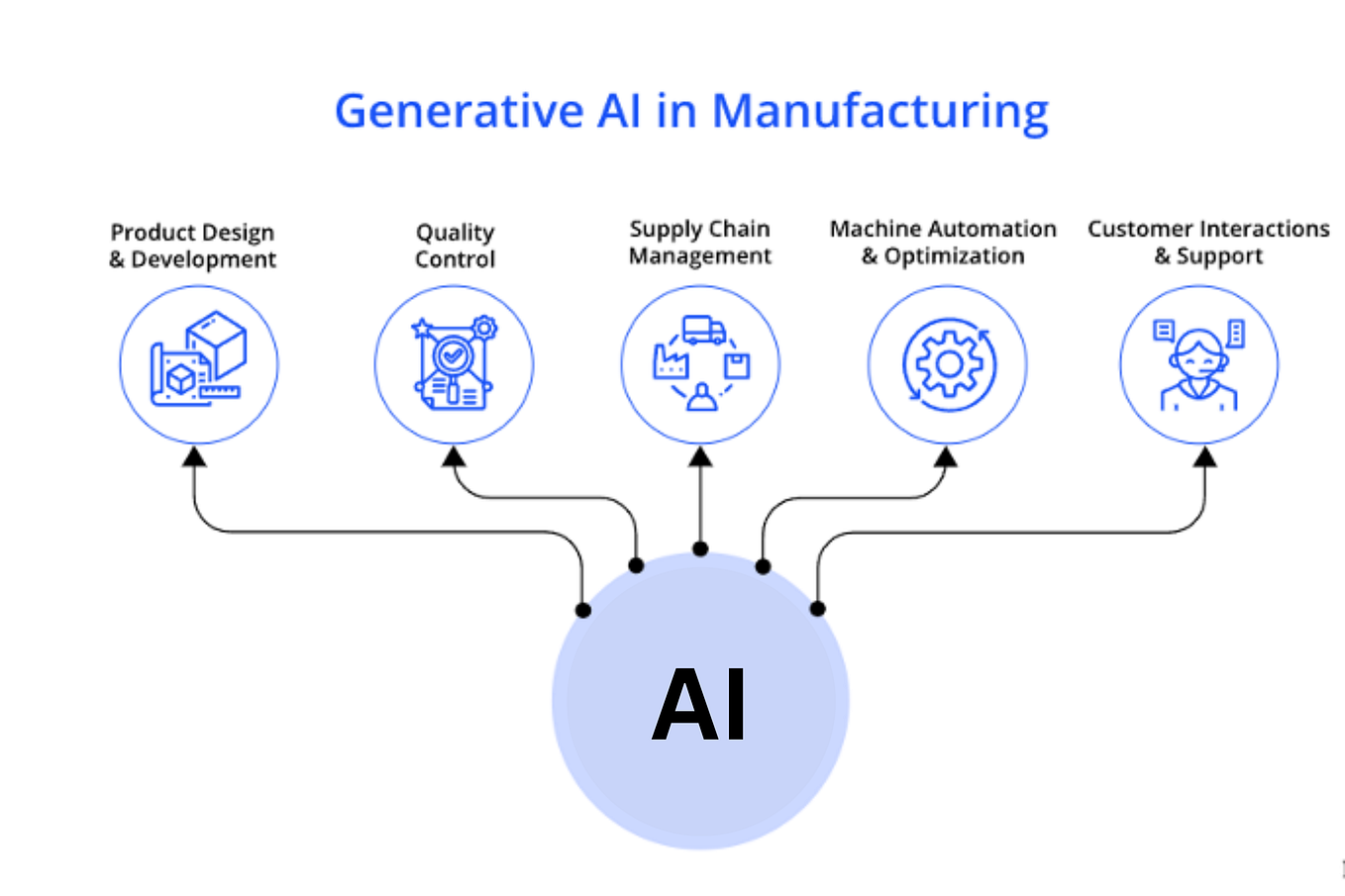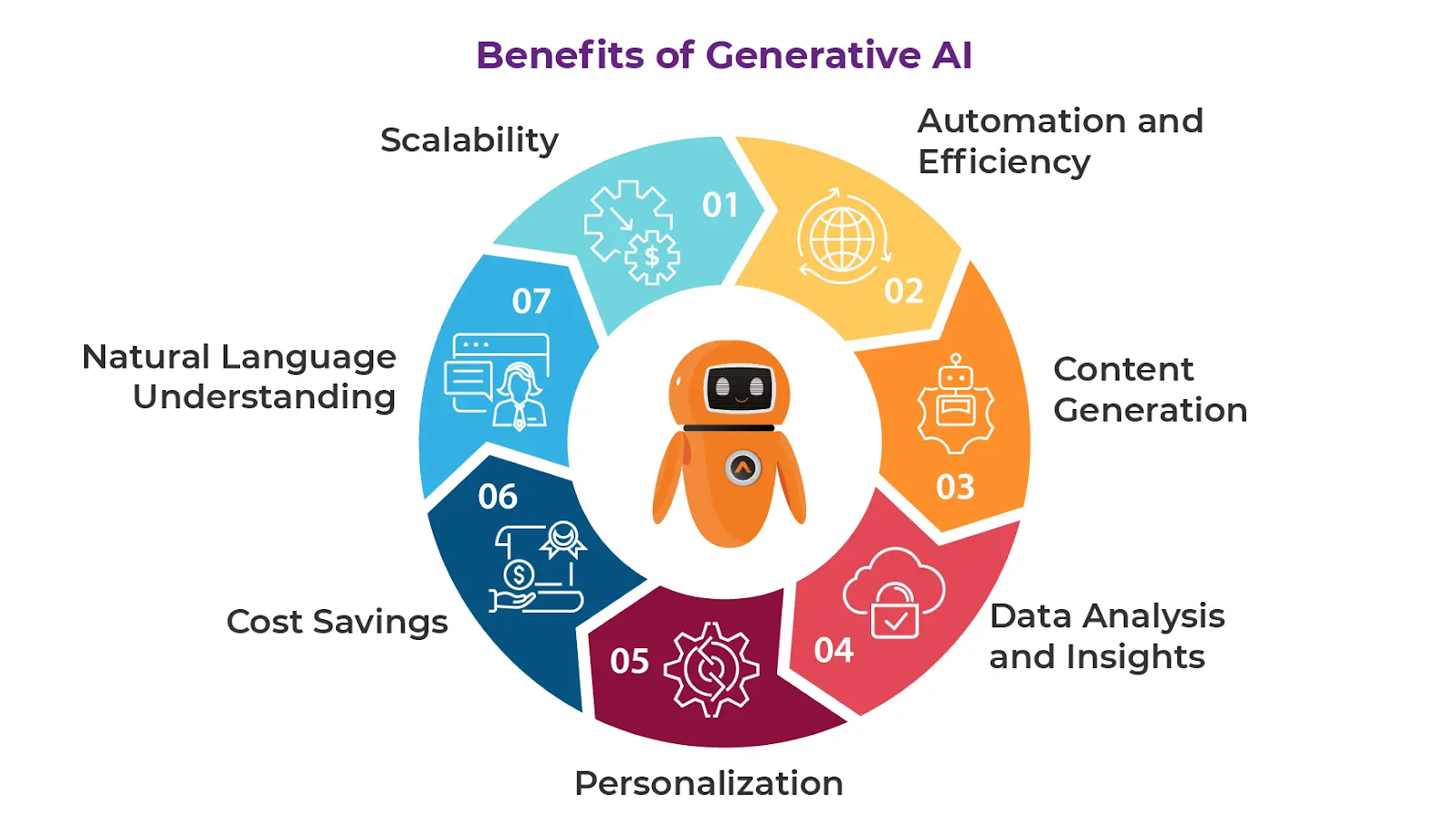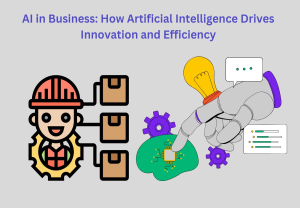Discover how Generative AI for Business is transforming enterprise operations, from product design and marketing to predictive analytics and customer engagement, enabling scalable innovation and efficiency.

-
Introduction: The Rise of Generative AI in Business
-
Understanding Generative AI
-
Large Language Models (LLMs)
-
Generative Adversarial Networks (GANs)
-
Diffusion Models
-
-
How Generative AI Transforms Business Operations
-
Content Creation and Marketing
-
Product Design and Innovation
-
Predictive Analytics and Decision Support
-
Customer Engagement and Experience
-
Process Optimization and Automation
-
-
Industry-Wide Applications
-
Finance
-
Healthcare
-
Manufacturing
-
Retail
-
Marketing and Creative Industries
-
-
Challenges in Generative AI Adoption
-
Best Practices for Responsible Generative AI
-
Emerging Trends in Generative AI for Business
-
Conclusion: Building the Intelligent Enterprise
Introduction: The Rise of Generative AI in Business
Generative AI for Business is now a strategic enabler, reshaping how enterprises design products, create content, optimize operations, and engage customers. Advanced models like LLMs, GANs, and diffusion models allow businesses to combine human creativity with machine intelligence at scale.
In today’s digital economy, Generative Artificial Intelligence (Generative AI) stands at the epicenter of enterprise transformation. No longer confined to research labs or creative studios, generative AI is now a strategic enabler—reshaping how businesses design products, create content, optimize operations, and engage with customers. Through advanced architectures such as Large Language Models (LLMs), Generative Adversarial Networks (GANs), and Diffusion Models, enterprises are unlocking new paradigms of innovation, productivity, and personalization at scale.
This article explores how generative AI is revolutionizing modern enterprises, examines its applications across key industries, highlights implementation challenges, and identifies emerging trends shaping the future of AI-driven business ecosystems.
Understanding Generative AI in the Business Context
Generative AI refers to systems that can generate new content, designs, or data patterns based on learned information. Unlike traditional AI models that recognize or classify existing data, generative models create original outputs—text, images, code, simulations, and even strategic insights.
Key Technologies Powering Generative AI
- Large Language Models (LLMs):
These models, such as GPT and Claude, are trained on massive datasets to understand and generate human-like text. They empower enterprises with automated communication, content generation, and knowledge synthesis capabilities. - Generative Adversarial Networks (GANs):
GANs use a dual-network architecture—a generator and a discriminator—to produce highly realistic images, videos, or data. They are widely adopted in marketing, design, and synthetic data generation for analytics. - Diffusion Models:
Used in cutting-edge applications such as image generation, simulation, and drug discovery, diffusion models iteratively refine data from noise into structured, meaningful output.
Collectively, these technologies are reshaping how organizations conceptualize innovation, offering scalable, data-driven creativity that blends human ingenuity with machine intelligence.
How Generative AI Transforms Business Operations
Generative AI acts as a strategic catalyst across the enterprise value chain. From ideation to execution, it enhances decision-making, accelerates innovation, and creates measurable business outcomes.
1. Content Creation and Marketing
Generative AI redefines the creative process by enabling hyper-personalized marketing at scale.
- Automated Copywriting: AI systems draft emails, blogs, and advertisements tailored to audience segments.
- Visual Design: Tools like Midjourney and DALL·E generate campaign visuals in seconds.
- Dynamic Customer Engagement: AI chatbots powered by LLMs deliver personalized responses that drive loyalty.
Example: A global e-commerce enterprise used a generative AI platform to automate ad creative generation, reducing campaign design time by 60% and increasing engagement by 25%.
2. Product Design and Innovation
Generative AI accelerates research and product design by simulating thousands of variations within seconds.
- 3D Modeling: AI generates complex design prototypes for manufacturing and architecture.
- Drug Discovery: In pharmaceuticals, AI models simulate molecular interactions to identify potential therapies.
- Fashion and Retail: AI creates new product lines by analyzing consumer trends and design patterns.
Example: BMW leverages generative AI in car design, using algorithms to optimize aerodynamics and aesthetics simultaneously, cutting development cycles by months.
3. Predictive Analytics and Decision Support
Generative models enhance forecasting accuracy and decision intelligence by producing simulated datasets that strengthen predictive analytics.
- Scenario Modeling: AI generates synthetic business scenarios for risk and performance analysis.
- Demand Forecasting: Generative models simulate market fluctuations to optimize supply chains.
- Financial Modeling: AI synthesizes alternative datasets to test investment strategies.
Example: A financial services firm used a generative AI-driven simulation engine to predict credit risk and market volatility, resulting in a 30% improvement in portfolio resilience.
4. Customer Engagement and Experience
Generative AI enables personalized and emotionally intelligent customer interactions:
- Conversational AI: LLM-powered chatbots deliver 24/7 customer support in natural language.
- Voice and Video Personalization: AI generates individualized audio or video messages based on customer data.
- Virtual Shopping Assistants: Retailers deploy generative AI to simulate human-like interactions, enhancing user satisfaction.
Example: Sephora integrated a generative AI-based recommendation system to deliver virtual makeup try-ons and personalized beauty consultations, boosting conversion rates significantly.
5. Process Optimization and Automation
Generative AI complements automation by enabling adaptive workflows that evolve with data patterns.
- Automated Report Generation: Enterprises use AI to summarize analytics and generate executive dashboards.
- Code Generation: AI copilots assist developers in writing, debugging, and optimizing software.
- Intelligent Document Processing: AI automates document classification and summarization in legal, HR, and compliance workflows.
Example: A global logistics provider integrated generative AI into its RPA infrastructure, achieving a 40% reduction in manual reporting time and improved operational visibility.
Industry-Wide Applications of Generative AI

Finance
Generative AI reshapes financial innovation, risk management, and customer interaction:
- Algorithmic Trading: AI models generate predictive market strategies and backtest simulations.
- Fraud Detection: Synthetic data generation strengthens anomaly detection models.
- Personalized Banking: LLMs deliver customized insights and financial advisory at scale.
Case Study: Morgan Stanley employs generative AI to assist financial advisors in real time, synthesizing client portfolios and market insights with conversational AI copilots.
Healthcare
In healthcare, generative AI drives precision medicine, operational efficiency, and diagnostic innovation:
- Drug Discovery: AI simulates molecular interactions to identify viable compounds.
- Medical Imaging: GANs enhance resolution and detect anomalies.
- Patient Interaction: Chatbots assist in appointment scheduling and symptom triage.
Case Study: Pfizer uses generative models for drug compound simulation, reducing R&D cycles from years to months.
Manufacturing
Generative AI transforms design, production, and predictive maintenance:
- Design Optimization: AI generates and tests design variations to improve performance.
- Supply Chain Resilience: AI models predict disruptions and suggest mitigation strategies.
- Predictive Maintenance: AI creates synthetic equipment data to forecast failures before they occur.
Case Study: General Electric implemented generative AI to optimize turbine design and maintenance, improving performance by 15% while reducing downtime.
Retail
Generative AI enables customer-centric innovation:
- Personalized Shopping Experiences: AI curates product suggestions and dynamic content.
- Inventory Forecasting: Synthetic data predicts consumer demand trends.
- AI-Powered Visual Merchandising: Generative models design virtual store layouts.
Case Study: Amazon employs generative AI for inventory planning and dynamic product imagery, enhancing conversion rates and reducing storage inefficiencies.
Marketing and Creative Industries
Generative AI revolutionizes content strategy, storytelling, and brand engagement:
- Creative Content Generation: AI writes, visualizes, and even scores advertising campaigns.
- Brand Voice Consistency: AI ensures tone and language coherence across platforms.
- Market Insight Generation: AI synthesizes large data pools to identify emerging trends.
Case Study: Coca-Cola’s “Create Real Magic” campaign used generative AI to allow consumers to co-create branded art, exemplifying the fusion of creativity and engagement.
Challenges in Generative AI Adoption
Despite its immense potential, the path to enterprise-scale generative AI comes with challenges requiring strategic foresight.
1. Data Governance and Quality
Generative AI is only as strong as the data it learns from. Poor data quality or lack of governance can lead to inaccurate or biased outputs, undermining trust and compliance.
2. Intellectual Property (IP) and Legal Risks
AI-generated content raises complex IP ownership and copyright questions. Enterprises must navigate regulatory frameworks to ensure ethical and lawful AI use.
3. Bias and Ethical Concerns
AI systems trained on biased datasets can perpetuate or amplify inequalities. Responsible design and model auditing are essential to ensure fairness.
4. Explainability and Transparency
Generative AI’s “black box” nature challenges interpretability. Businesses require explainable AI frameworks to validate decision processes, especially in regulated industries like finance and healthcare.
5. Integration and Scalability
Integrating generative AI into legacy systems and workflows demands robust architecture, data interoperability, and cross-functional collaboration.
Best Practices for Responsible and Scalable Generative AI
- Establish Strong Data Governance: Implement standardized policies for data collection, labeling, and usage.
- Adopt Ethical AI Frameworks: Ensure AI alignment with human values, fairness, and transparency.
- Invest in Explainability: Integrate interpretability tools to understand AI decision paths.
- Foster Cross-Functional Collaboration: Combine expertise from business, IT, and compliance teams.
- Scale Strategically: Start with high-value use cases, then expand enterprise-wide adoption.
Example: Microsoft’s Responsible AI framework emphasizes fairness, reliability, inclusiveness, and transparency, setting a benchmark for enterprise AI governance.
Emerging Trends in Generative AI for Business

Multimodal AI
Next-generation generative AI integrates text, image, video, and audio understanding, enabling richer, more immersive experiences—vital for sectors like entertainment, e-commerce, and education.
AI Copilots
AI copilots act as intelligent assistants across business functions—from coding and data analytics to sales enablement—enhancing productivity and decision-making.
Enterprise-Grade AI Platforms
Organizations are adopting customizable AI ecosystems that integrate data pipelines, governance modules, and security layers, enabling safe, scalable AI deployment.
Synthetic Data Generation
To protect privacy and strengthen analytics, enterprises leverage synthetic datasets generated by AI to simulate realistic but non-identifiable information.
Continuous Learning and Adaptation
Future generative systems will self-improve, integrating real-time data streams for adaptive, context-aware intelligence that evolves alongside the enterprise.
Conclusion
Generative AI for Business represents the dawn of a new intelligence era—where creativity, strategy, and automation converge. From generating marketing content and designing products to optimizing supply chains and forecasting trends, generative AI is not just enhancing efficiency; it is redefining competitive advantage.
As enterprises embrace this transformative technology, the focus must shift from experimentation to responsible, scalable implementation—anchored in transparency, governance, and ethical innovation.
For forward-looking organizations, generative AI is not simply a tool but a strategic partner, enabling them to innovate faster, operate smarter, and build the intelligent enterprise of the future.


